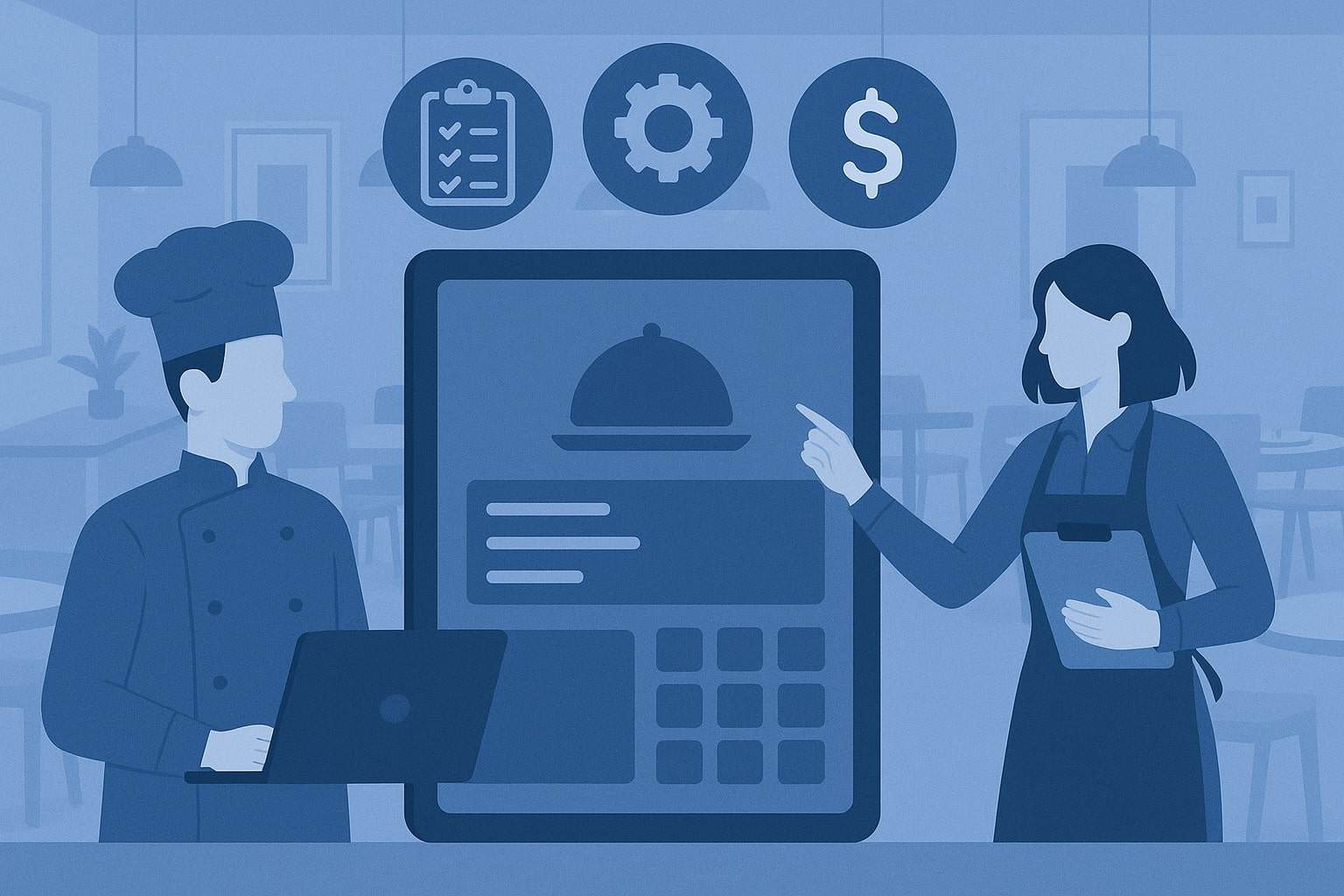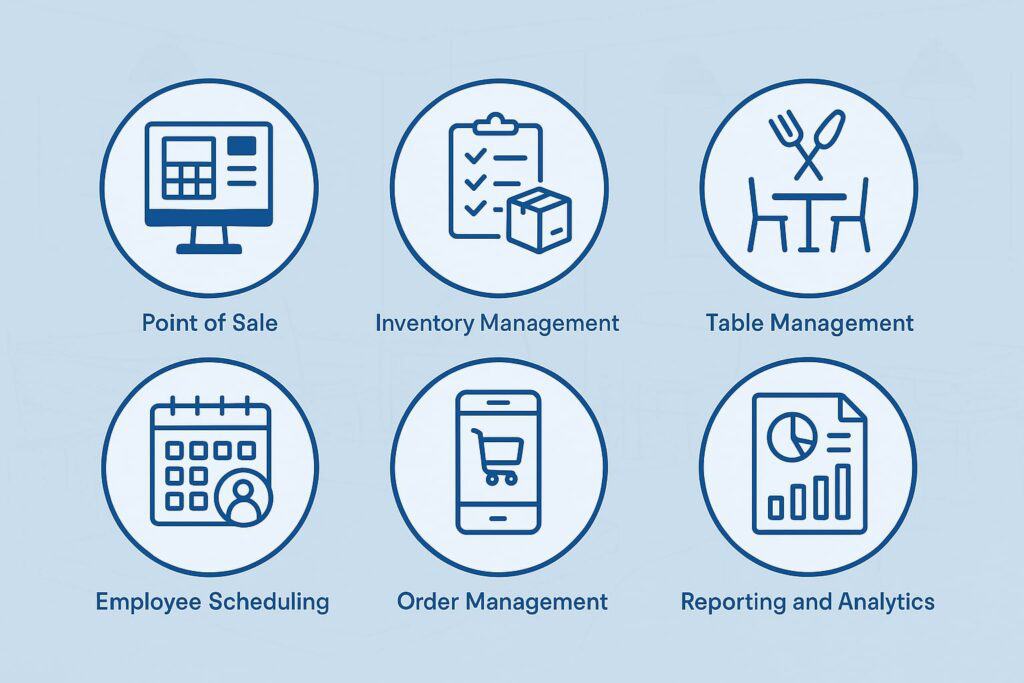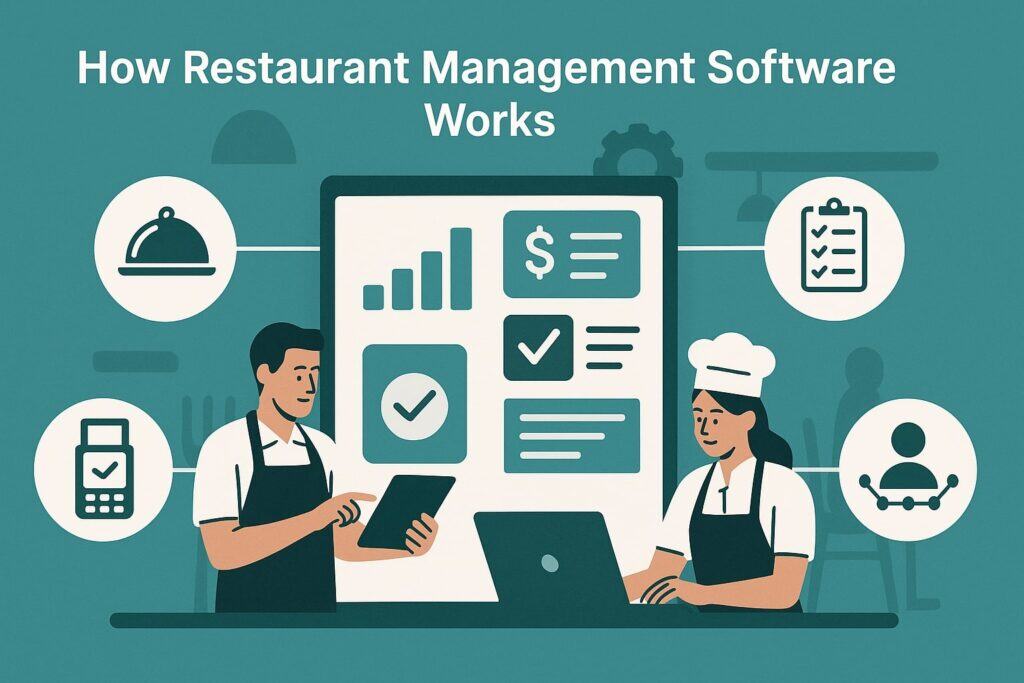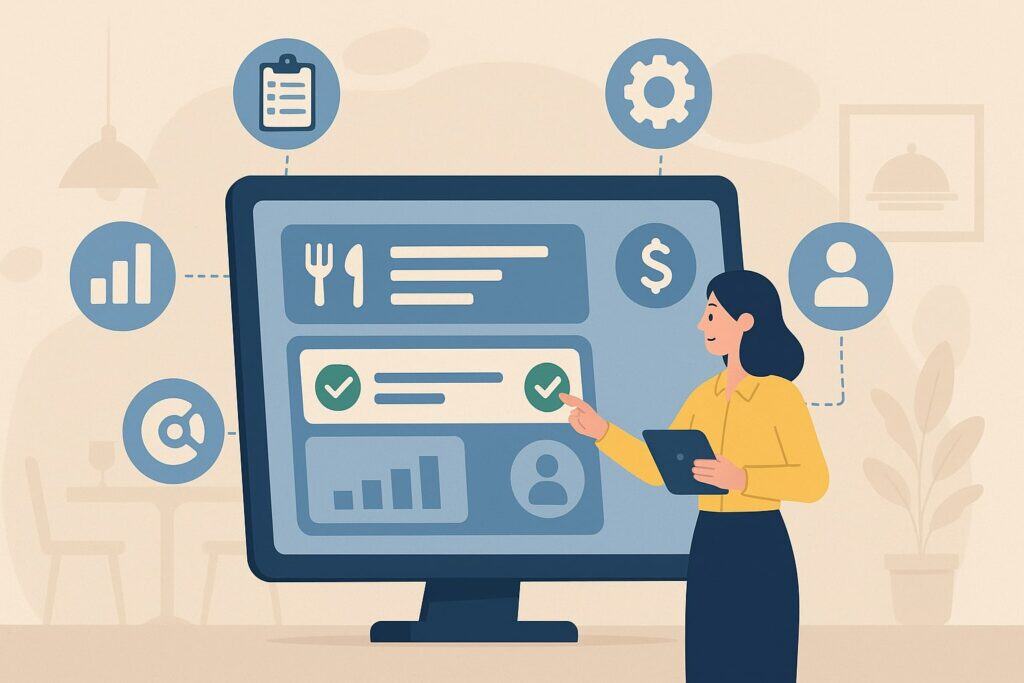
By cloudrestaurantmanager September 27, 2025
Restaurant management software (RMS) is a comprehensive, integrated system designed to manage all aspects of running a restaurant from a single platform. In other words, it acts as the restaurant’s “nervous system,” automating tasks and connecting different parts of the business.
A modern RMS typically includes a point-of-sale (POS) component for taking orders and processing payments, plus back-end tools for inventory control, employee scheduling, reporting, and more.
By centralizing these functions, RMS helps restaurant owners and staff improve efficiency, reduce errors, and focus on delivering great customer service rather than manual administration.
According to industry research, the adoption of cloud-based restaurant systems is rising rapidly. For example, a 2023 survey found that 76% of restaurants were using cloud POS solutions, compared to just 23% on legacy local systems.
In North America – the largest RMS market by far – the majority of operators now rely on internet-hosted platforms. Cloud deployment lets managers access real-time sales, inventory, and staffing data from anywhere (even multiple locations) and eliminates much of the on-site IT overhead.
In practice, this means a manager can check sales on a tablet or smartphone, or push menu updates to tablets across all stores with a few clicks.
A restaurant manager using an iPad to take orders. Modern restaurant management software often runs in the cloud, allowing staff to use tablets or mobile devices for order entry and management tasks.
For example, when a server taps an order on a tablet, the system can instantly send it to the kitchen, update inventory levels, and record the sale in real time. Many cloud-based systems also offer offline mode – continuing to work if the internet goes down and syncing data later.
In short, RMS platforms tie together front-of-house devices (tablets, cash registers, kitchen screens) and back-office functions so that orders, payments, inventory changes, and staff hours all flow seamlessly into one database.
Core Components of Restaurant Management Software

A restaurant management system typically combines the following key components into one solution:
- Point of Sale (POS): The POS is at the heart of the system. It handles order taking (dine-in, takeout, delivery), payment processing (cash, cards, mobile wallets), and sends orders to the kitchen or bar.
A robust POS is often tailored to the restaurant type (quick service, full-service, bar, etc.) to optimize order flow and customer experience. - Inventory and Purchasing: RMS tracks stock levels of ingredients and supplies in real time. When ingredients run low, it can automatically generate purchase orders or alert managers. This streamlines procurement and helps minimize waste and spoilage by matching orders to actual usage.
- Table and Reservation Management: Many systems include floor and table planning tools. These modules manage reservations, optimize seating arrangements, and handle waitlists.
By giving hosts real-time visibility of which tables are occupied or coming available, the software can reduce wait times and improve dining room flow. - Staff Scheduling and Timekeeping: RMS often includes employee management features to create and publish staff schedules, track clock-in/out times, and calculate labor costs.
These tools help ensure there are enough team members during peak hours while avoiding overstaffing during slow periods. They also tie into payroll, ensuring accurate employee pay and tip distribution. - Reporting and Analytics: A powerful RMS generates detailed reports on sales, labor, inventory, and other metrics. Owners can quickly see which menu items are selling, how labor is being utilized, and where costs are rising.
These insights enable data-driven decisions – for example, which dishes to promote or which hours to schedule more staff. - Customer Relationship Management (CRM): Many systems include or integrate with CRM tools and loyalty programs. The software can record customer visit histories, preferences, and contact information.
This enables personalized marketing (e.g., sending offers to frequent diners) and supports loyalty or gift card programs to encourage repeat business. - Online Ordering and Delivery Integration: Modern RMS often connect directly to online ordering websites and third-party delivery platforms (Uber Eats, DoorDash, Grubhub, etc.).
Orders from the restaurant’s own website or a delivery app can flow directly into the POS just like in-restaurant orders. This reduces double-entry and keeps inventory and sales data synchronized across all channels.
By bundling these modules together, restaurant management software provides an all-in-one solution. Instead of running separate apps for ordering, inventory, payroll, and reporting, staff and owners use a single system.
This reduces duplication of work (such as re-entering orders into an accounting spreadsheet) and helps ensure that all data is consistent. As one provider puts it, RMS “integrates multiple functionalities into a single platform, providing a centralized system to manage operations, improve efficiency, and enhance overall productivity”.
How Restaurant Management Software Works

At a high level, restaurant management software works by linking front-of-house ordering and service to back-of-house operations through a central software backbone. Here’s a simplified workflow:
- Order Entry: A server or cashier selects menu items on a POS terminal or handheld device. This information is immediately sent to kitchen displays or printers, and the order is logged in the system.
- Inventory Update: Once an order is entered, the software automatically deducts ingredients from the inventory. If stock is low, the system can generate reorder alerts or purchase orders.
- Payment Processing: The payment is captured by the POS (card reader, mobile pay, etc.), and the sale is recorded. Many systems integrate with payment processors, ensuring secure transactions and avoiding manual entry of totals.
- Data Recording: Sales, tax, and tip data are saved in the database. If integrated with accounting, daily totals can be pushed to bookkeeping software or a general ledger automatically.
- Reporting: Managers can pull reports at any time – for example, a daily sales summary or a detailed breakdown of labor costs. Some systems offer dashboards that update in real time.
- Notifications & Alerts: The system can notify staff of relevant events. For instance, a fridge temperature breach (for food safety), or an employee punching in late, can trigger alerts.
Most modern restaurant management systems are cloud-based SaaS solutions. This means the software and database reside on remote servers, and restaurant devices (POS terminals, tablets, even personal phones) connect via the internet to access it.
Cloud RMS provides several advantages: automatic software updates, remote access from any location, and the ability to easily add new locations. As one market report notes, “restaurants are increasingly relying on cloud-based solutions” because they offer greater scalability and real-time analytics.
For example, a multi-unit chain can have all locations upload data to the same cloud server – corporate headquarters can then analyze all store performance from one dashboard.
However, many RMS also offer on-premise or hybrid modes for stores without reliable internet. In an on-premise setup, a local server within the restaurant holds the data and may replicate it to the cloud later.
According to industry research, while cloud POS is dominant, a minority of very large or remote restaurants still use legacy on-site systems. Modern cloud systems often include an offline mode: if the internet goes down, the POS can continue to process payments and queue orders, then sync the data back to the cloud when reconnected.
Integration is a key strength of RMS. Most platforms expose APIs or built-in connectors to link with other software. Common integrations include accounting packages (like QuickBooks), hotel property management systems, reservation services (OpenTable, Resy), and vendor ordering portals.
For instance, when an online order comes in from a third-party delivery app, the RMS can automatically adjust inventory and include that sale in reports just as if it had been placed by a waiter.
Such seamless integration streamlines operations – as one analysis explains, cloud RMS enables “real-time tracking of orders, automated inventory updates, and enhanced customer engagement” by linking in-house and delivery channels.
Benefits of Restaurant Management Software

Adopting a good RMS brings numerous benefits to a restaurant’s operations and bottom line. Key advantages include:
- Streamlined Operations: RMS automates routine tasks (order-taking, ticket printing, inventory counts, scheduling) so staff spend less time on manual work.
With a single system handling many functions, there is no need to juggle multiple apps. This reduces mistakes (like transposed orders) and helps service run smoothly. - Increased Efficiency: Centralized data eliminates duplicate entry. For example, sales from every channel (in-restaurant, online, delivery) are recorded once in the RMS, rather than keyed into separate spreadsheets.
Staff can serve more tables faster when the system handles calculations and coordination. A Brookings study noted that RMS users see labor needs and turnover decrease because the software “boost[s] profit margin and revenue” by optimizing resource use. - Improved Customer Experience: RMS helps restaurants serve customers more quickly and personally. Table management tools reduce wait times, and CRM features allow staff to recall repeat diners and special requests.
Loyalty programs and gift card integrations, managed by the RMS, also keep customers coming back. Overall, faster service and personalization translate to happier guests and better reviews. - Better Inventory Control: By tracking stock in real time, RMS minimizes food waste and prevents stockouts.
Accurate inventory data can cut costs significantly – for example, a 1% improvement in inventory accuracy can lead to thousands of dollars in savings for a multi-location chain. SMS Alert-Enabled Reordering ensures restaurants only buy what they need. - Data-Driven Decisions: Perhaps the biggest payoff is the analytics. An RMS’s reports help owners spot trends (“burger sales spike on game nights,” “new menu item underperforming,” etc.) and act on them.
In fact, industry reports highlight that chains leveraging analytics and even AI (for sales forecasting and menu engineering) gain a “competitive edge”. These insights allow restaurants to adjust staffing, pricing, and promotions to improve margins over time. - Cost and Waste Reduction: With detailed labor and inventory data, RMS helps control expenses. For instance, scheduling tools ensure that more workers are on duty when the store is busy, and fewer during lulls.
This prevents overstaffing, which can eat into profits. Automated inventory orders prevent over-ordering expensive ingredients. All together, systematic monitoring of food costs and labor costs leads to stronger financial performance. - Scalability: Whether you run a single café or a national chain, RMS can scale to fit. The same software (usually with higher-tier plans or add-ons) can handle multiple locations, making expansion smoother.
Multi-unit operators benefit from centralized control: for example, menu changes or pricing updates can be deployed to all locations instantly. Chains using cloud RMS report that data remains “consistent across locations,” which is crucial for brand standards. - Compliance and Security: Quality RMS often include features for regulatory compliance and security. For instance, they can enforce labor law rules (required breaks, overtime limits) in scheduling, and provide audit trails for food safety checks.
Credit card data is handled by PCI-compliant payment modules, reducing the risk of fraud. Automating compliance tasks (like temperature logs) also saves manual paperwork and helps avoid fines. - Increased Profitability: All of the above translate into a healthier bottom line. Surveys of restaurateurs show that implementing RMS generally boosts revenue and margins.
Fewer errors, less waste, faster service, and repeat customers – these factors add up. As one trade publication notes, RMS allows operators to focus on strategy and guest experience instead of routine tasks, which in turn drives growth.
In summary, restaurant management software makes operations faster, smarter, and more profitable. It replaces manual logbooks and disjointed tools with an integrated system that empowers managers with real-time information and automation.
Comparison of Leading Restaurant Management Software
There are many RMS platforms on the market, each with its own strengths. The right choice depends on your restaurant’s size, service style, and budget. Here are brief comparisons of some popular solutions:
- Toast: A comprehensive, all-in-one system built exclusively for restaurants. Toast offers robust features like menu management, kitchen display systems (KDS), loyalty programs, and built-in payroll/scheduling.
It targets mid-sized to large establishments and supports multiple locations. Toast is known for its durable hardware (tablets, terminals, handhelds) and offers a flexible pricing model (including a $0 upfront hardware option for a higher transaction fee).
It excels in restaurant-specific tools (e.g. splash-proof devices, self-order kiosks) but often requires contracts and extra fees for add-ons. Toast is generally recommended for busy restaurants that need an “all-in-one system capable of scaling” with advanced back-office features. - Square for Restaurants: A user-friendly, entry-level RMS ideal for small eateries, cafes, and food trucks. Square offers a free POS software plan (with optional paid tiers) and inexpensive hardware (card readers and terminals).
It handles orders, payments, and basic inventory out of the box. As one reviewer notes, Square “wins on price transparency and ease of setup” – there are no long-term contracts and you can start accepting credit cards almost immediately.
However, Square’s feature set is more basic: while it covers fundamental needs (table layout, menu management, simple reporting), it lacks some of the deep restaurant-specific tools (like advanced labor reporting) found in Toast or Lightspeed.
Square does include online ordering and loyalty functions, but larger restaurants may find they need specialized features beyond Square’s core offering. - Lightspeed Restaurant (Upserve): A flexible cloud-based POS known for speed and powerful analytics. Lightspeed touts its restaurant system as “40% faster on average than other leading systems”.
It provides all the usual modules (menu, tableside ordering, payment processing, KDS, inventory, etc.) plus strong reporting and back-office tools. Lightspeed supports offline mode (work continues during internet outages) and can manage an unlimited number of locations from one account.
It’s suitable for mid-sized and large restaurants that want detailed business intelligence. One downside is that Lightspeed’s comprehensive features often come at a higher price point than more basic systems. - TouchBistro: An iPad-centric POS designed for ease of use. TouchBistro runs entirely on iOS devices, which means hardware is relatively inexpensive if you already have iPads on hand.
It includes built-in reservation and menu modules and is often praised for its intuitive interface. Compared to Toast, TouchBistro is simpler and typically involves shorter contracts.
It’s a good choice for single-location or small multi-location establishments that want basic RMS functionality without a steep learning curve.
(For example, one analyst advises: “Choose TouchBistro when you want simple built-in payment processing, need a shorter contract, or prefer iPads.”.) TouchBistro’s feature set is slightly lighter – for instance, inventory tracking is available but requires a paid add-on in some cases – but it gets the core job done affordably. - Oracle MICROS / NCR Aloha: These are traditional enterprise-grade systems favored by large chains and hotels. Oracle’s MICROS platform (and NCR’s Aloha, which Oracle now owns) offers a full suite of POS, back-office, and kitchen systems.
They can be deployed on-premise or in the cloud. According to market analysts, Oracle MICROS solutions “help businesses improve operational efficiency and enhance customer experiences” across quick-service and full-service venues.
These systems are very powerful and customizable, but also typically require significant investment and IT support. Smaller restaurants rarely use MICROS because it’s geared toward high-volume operations with complex needs. - Other Notable Platforms: There are many other players. Revel Systems and Lightspeed (by Lightspeed POS, formerly Upserve) target medium to large restaurants. Clover (by Fiserv) provides all-in-one terminals that appeal to small cafes.
Jolt offers labor and task management for restaurants. Restaurant365 focuses on accounting integration. Square for Restaurants (mentioned above) continues to expand its features. Each platform balances factors like hardware choice, customization, support, and cost differently.
In general, smaller venues tend to choose Square, TouchBistro, or Clover for their low entry cost and simplicity. Larger restaurants or chains often select Toast, Lightspeed, or enterprise systems because they need advanced features and can absorb higher costs.
As one tech review summarized: “Toast stands out for mid- to large-sized food businesses thanks to its restaurant-specific features,” while Square is “best for small food businesses due to its affordability and simplicity”. Lightspeed and others fit in between, offering very robust tools for full-service operations.
FAQs
Q: What is restaurant management software?
Answer: It’s an integrated system that helps restaurants handle all operations in one place – from taking orders and processing payments to tracking inventory, managing staff schedules, and analyzing sales.
Essentially, it replaces paper logs and siloed apps with a unified solution. A good RMS will include a point-of-sale (POS) module along with back-office modules for inventory, labor, CRM, etc. The goal is to streamline workflow so owners can focus on serving customers rather than paperwork.
Q: How does restaurant management software differ from a standard POS?
Answer: A basic POS (Point of Sale) system only handles sales transactions – order entry and payment. Restaurant management software includes the POS and much more. It integrates the POS with inventory management, vendor purchasing, employee scheduling, customer loyalty, reporting, and so on.
In other words, RMS is a superset of POS functions. For example, while a POS can process a sale, an RMS will simultaneously deduct ingredients from inventory, log labor for the server, and update daily sales reports.
Q: Why should I use restaurant management software?
Answer: The main benefits are efficiency and insight. RMS automates manual tasks (order-taking, inventory counts, payroll math), reducing errors and labor costs. It also provides real-time data, so you can quickly see what’s selling and what’s not.
This means better decision-making – for instance, spotting unprofitable menu items or adjusting staffing based on accurate sales forecasts. Overall, RMS can increase revenue (through faster service and repeat customers) and decrease waste (through tighter inventory and labor controls).
Q: Should my software be cloud-based or on-premise?
Answer: Most new restaurants opt for cloud-based solutions because they are easier to set up, update automatically, and can be accessed from anywhere. Cloud systems also automatically back up data and integrate well with online services.
However, if your location has unreliable internet or you have strict control requirements, an on-premise system (with a local server) might be considered. Today, even cloud systems typically offer an offline mode to handle short network outages.
Q: What does restaurant management software cost?
Answer: Pricing varies widely. Some providers (like Square) offer a free basic software plan and let you use your own devices. Others (like Toast) charge a monthly subscription plus transaction fees. Hardware costs can also apply (tablets, terminals, printers).
For example, Toast offers a starter bundle for $0 upfront hardware (covered by higher processing fees) or $69–$578 per month plus standard card fees.
Many systems have tiered plans or add-ons, so the total can range from a few hundred dollars a year for a small restaurant to $1,000+ per month for a large, multi-terminal setup. It’s important to compare not just the price, but what features are included.
Q: Which software is best for a small restaurant or café?
Answer: Small operations often benefit from user-friendly, low-cost RMS. Square for Restaurants and TouchBistro are frequently recommended, as they require minimal upfront investment and are easy to learn.
They cover the essentials (menu management, payments, basic reports) without overwhelming features. As a rule of thumb, if you have only one location and mainly need a quick way to take orders and track sales, a simpler system like Square or TouchBistro will often suffice. Larger or multi-location venues may prefer a more robust platform like Toast or Lightspeed.
Q: Can restaurant management software connect to other systems?
Answer: Yes. Integrations are a key feature of modern RMS. Most systems can link with online ordering sites, food delivery apps (Uber Eats, DoorDash), accounting software (QuickBooks, Xero), email marketing tools, and more.
For example, orders from a restaurant’s website can automatically appear in the RMS. Integration means less manual work (no need to enter the same data twice) and more accurate real-time information.
Q: What hardware do I need for restaurant management software?
Answer: Typically, you need at least one POS terminal (a tablet or computer running the software) and devices to take payments (card readers or a terminal). Most systems also use kitchen printers or display screens.
Many RMS today support standard devices: you can often bring your own iPads or Android tablets. Some vendors (like Toast) sell specialized hardware bundles built for restaurant use. The specific requirements will depend on which software you choose and what devices you already own.
Q: Will restaurant management software really improve my restaurant?
Answer: If implemented well, yes. The most successful adopters report smoother service, fewer stockouts, and better labor cost management. With RMS, managers spend less time reconciling sheets of paper and more time analyzing performance.
As one industry guide points out, RMS helps owners “focus on delivering exceptional dining experiences rather than getting bogged down by manual processes”. In other words, by automating back-office work, RMS frees you up to improve front-of-house service, which drives customer satisfaction and loyalty.
Conclusion
Restaurant management software has evolved into an indispensable tool for modern foodservice businesses. It unifies a restaurant’s operations – from point-of-sale transactions to inventory to HR – into one system, making everything more efficient and data-driven.
With cloud-based solutions becoming the norm, even small independent diners can leverage powerful RMS platforms to compete with larger chains. Over the next few years, these systems will only get smarter, adding more analytics and even AI-driven forecasts to help restaurants anticipate demand.
Ultimately, the best RMS is the one that fits your restaurant’s needs and budget. Whether you run a one-location café or a nationwide franchise, there is a restaurant management software solution designed to help you operate more smoothly and profitably.
By choosing the right platform and using it to its full potential, restaurant owners can transform day-to-day chaos into a streamlined, enjoyable business – serving better food and experiences to customers, while running the back of the house like clockwork.